High-Speed Calcium Imaging
Prof. Kirill Volynski
Institute of Neurology, University College London, UK
Background
The Volynski lab, led by Kirill Volynski, Professor of Neuroscience at University College London (UCL), is primarily interested in understanding the regulation of neurotransmitter release which forms the basis of communication among neurons in the brain.
As explained by Prof. Volynski, "Synapses between neurons are critical sites of modulation and plasticity, both in health and in disease. Therefore detailed knowledge of the cellular mechanisms that regulate synaptic transmission at the level of individual synapses is a prerequisite for understanding the operation of complex neuronal circuits."
"We have recently developed new imaging methods which, for the first time, allow us to study the relationship between Ca2+ entry and vesicular exocytosis, and to probe presynaptic ion channel function in individual small presynaptic terminals. This is based on using fluorescence microscopy to image rapid changes in the concentration and rate of vesicle discharge of Ca2+ ions; and on the use of super-resolution scanning ion conductance microscopy for patch-clamp recordings from small presynaptic boutons."
"Using these methods we investigate how different channels that mediate Ca2+ influx into the terminal control the release of vesicles, how they influence synaptic plasticity, and how synapses are influenced by other modulatory neurotransmitters acting upon presynaptic terminals."
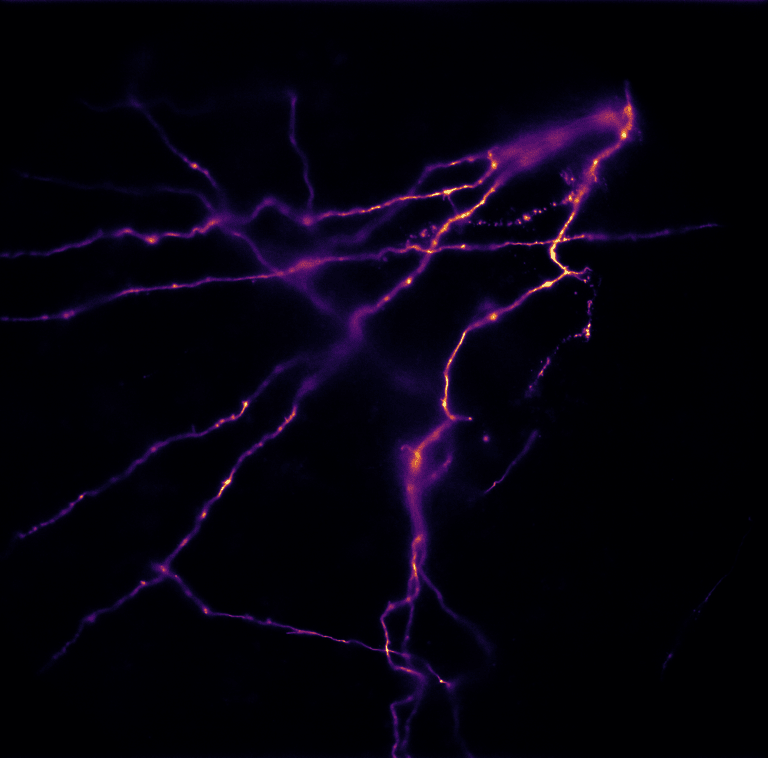
Figure 1: Axonal arbor of a hippocampal neuron in culture expressing glutamate sniffer SF-iGluSnFR probe, acquired with the Kinetix
sCMOS.
Challenge
High-speed Ca2+ imaging requires both sensitivity and speed. Previously Prof. Volynski's lab was using a Prime 95B 25mm to maximize sensitivity and field of view while achieving high speeds of acquisition. This camera provided a considerable upgrade in terms of speed, the field of view (FOV), and stability to an earlier EMCCD solution. But the speed of the camera was still a limiting factor both for keeping up with the high-speed dynamics in the sample, but also for light acquisition, due to the necessity to use a 'pseudo-global shutter' trigger to control the light source.
In a rolling shutter camera such as the Prime 95B, the acquisition of a frame starts at the top of the sensor and very quickly sweeps down to the bottom. Although the time difference between the top and bottom of the sensor is very small, it can introduce distortions into highly precise high-speed experiments, so a 'pseudo-global shutter' must be used in order to capture the entire sensor at once. This works by using advanced hardware triggering to begin acquisition of an image only when all of the camera sensor rows are acquiring, then deactivating until the next frame. This concept is outlined in a timing diagram in Figure 2.
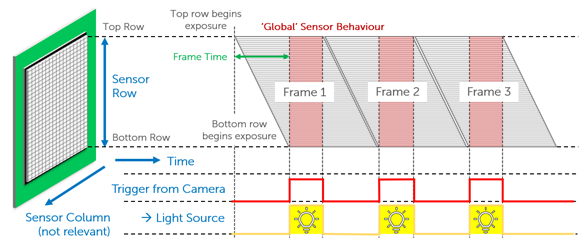
Figure 2: The timing of rolling shutter cameras, and using triggering of the light source to achieve global behavior.
The time the camera must wait until exposure begins is known as the 'dead time' or 'frame time' and is directly determined by the camera frame rate. With a faster camera, more global data could be acquired.
The low noise and high readout speed of the Kinetix allow us to capture more photons while imaging at a faster rate.
Prof. Kirill Volynski
Solution
The Kinetix is a groundbreaking sCMOS camera that provides the same near-perfect 95% quantum efficiency as the Prime 95B while measuring signals more accurately thanks to the lower read noise of its 'Sensitivity' mode. Other improvements come in both frame rate and sensor size. The Kinetix is a 10 Megapixel camera with an enormous 29.4 mm diagonal sensor - in its 'Sensitivity' mode, this entire field of view can be read out at 88 frames per second, but the Kinetix also has a 'Speed' mode, where the entire 10 MP sensor is read at an astonishing 500 frames per second.
What improvements will the Kinetix 'Sensitivity' and 'Speed' modes have for pseudo-global shutter imaging?
Sensitivity Mode: More Exposure Time
Something vital for Prof. Volynski is extending the effective exposure time, namely the 'frame time' plus the 'trigger on' time. The Kinetix has a much faster frame time than the Prime 95B, does this result in greater effective exposure time if we compare a similar 200-row region of interest (ROI) between the Kinetix in Sensitivity mode and the Prime 95B?
With a 200-row ROI both cameras have a speed of 300 fps leaving 3.3 ms per frame. The difference is the frame time: 2.08 ms for Prime 95B leaving 1.25 ms for the light source to be on and photons to be collected; and 0.71 ms for the Kinetix in Sensitivity mode leaving 2.6 ms for the light source to be on, more than double that of Prime 95B. In this manner, the shorter frame time of the Kinetix allows for a longer effective exposure at the same frame rate, as outlined in Figure 3.
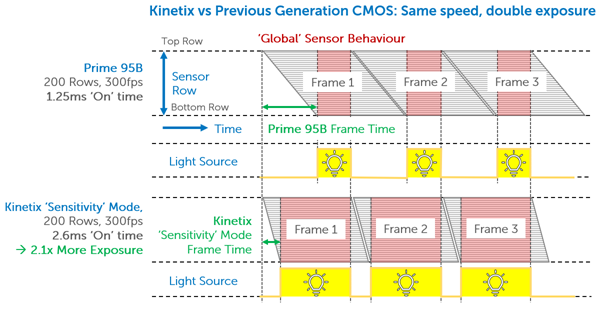
Figure 3: Timing diagram for Pseudo-Global Shutter mode for the Prime 95B and Kinetix (Sensitivity).
Each camera runs at 300 fps across a 200 row ROI. Due to the shorter frame time, the Kinetix in
its 'Sensitivity' mode is able to achieve a significantly longer 'Trigger On' time during which
light can be collected.
Speed Mode: More Exposure Time and Higher Speeds
As well as a greater effective exposure time, Prof. Volynski also looks for high speeds in order to capture dynamic calcium activity. This is where the Kinetix Speed mode comes in, operating at 500 fps across the whole sensor and allowing for capture of ultra-fast features.
If we look at the same example as the previous comparison but with the Kinetix in Speed mode, the frame time is so short (0.13 ms) that there is time for a 200-row acquisition, resulting in an overall framerate of 600 fps. Even with this doubling of the acquisition speed, the trigger on time is still 20% longer than the Prime 95B at 1.54ms, providing both more speed and more illumination time as shown in Figure 4.
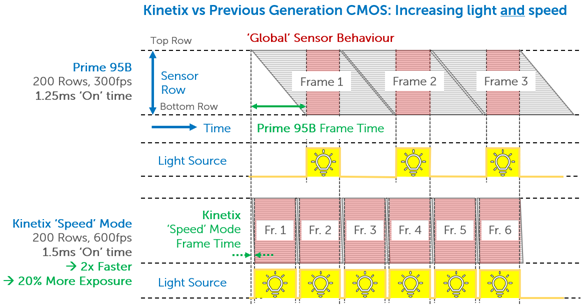
Figure 4: Timing diagram for Pseudo-Global Shutter mode for Prime 95B and Kinetix (Speed). Same target of 300 fps and 200-row ROI as
previous.In its Speed mode, the frame time of the Kinetix is so much faster that twice the number of frames can be collected in the same
time period, but also maintaining a 20% longer 'Trigger On' time per frame during which light can be collected.
Summary
The Kinetix is a groundbreaking combination of speed and sensitivity, offering ultra-high speeds across a huge sensor with ultra-low noise contributions. As well as being powerful, the Kinetix is also highly flexible, allowing for fine control over readout using advanced hardware triggering and readout modes such as Pseudo-Global Shutter.
The speed increase the Kinetix provides over previous generation CMOS cameras can lead to a significant increase in effective exposure time for increased light collection in pseudo-global shutter applications with its 'Sensitivity' mode. Furthermore, the incredibly fast frame time of the 'Speed' mode can provide speed increase combined with effective exposure time increases.
The Kinetix also does this while delivering an 18% larger horizontal field of view, due to the larger width of the Kinetix sensor.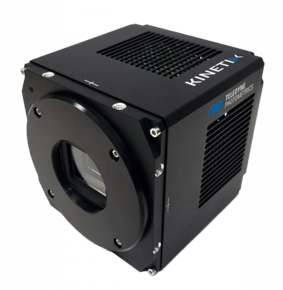
Learn More About The Kinetix
Download This Customer Story